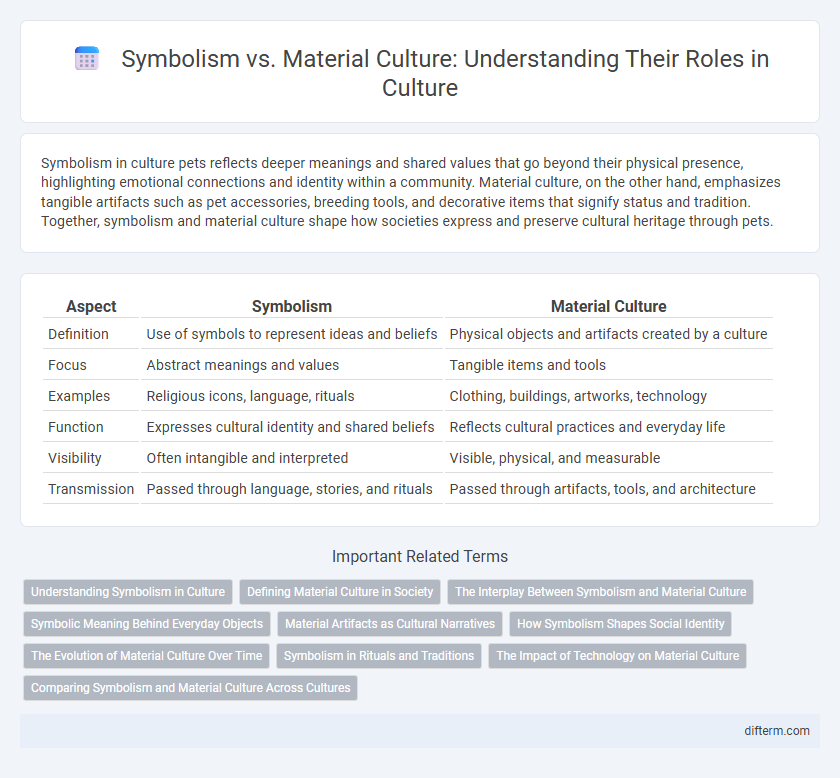Symbolism in culture pets reflects deeper meanings and shared values that go beyond their physical presence, highlighting emotional connections and identity within a community. Material culture, on the other hand, emphasizes tangible artifacts such as pet accessories, breeding tools, and decorative items that signify status and tradition. Together, symbolism and material culture shape how societies express and preserve cultural heritage through pets.
Table of Comparison
| Aspect | Symbolism | Material Culture |
|---|---|---|
| Definition | Use of symbols to represent ideas and beliefs | Physical objects and artifacts created by a culture |
| Focus | Abstract meanings and values | Tangible items and tools |
| Examples | Religious icons, language, rituals | Clothing, buildings, artworks, technology |
| Function | Expresses cultural identity and shared beliefs | Reflects cultural practices and everyday life |
| Visibility | Often intangible and interpreted | Visible, physical, and measurable |
| Transmission | Passed through language, stories, and rituals | Passed through artifacts, tools, and architecture |
Understanding Symbolism in Culture
Symbolism in culture represents the use of signs, objects, and rituals to convey meanings beyond their physical attributes, serving as a framework for shared beliefs and values within a society. Unlike material culture, which encompasses tangible artifacts like tools, clothing, and architecture, symbolism operates in the realm of abstract communication and identity formation. Understanding symbolism reveals how communities interpret their history, social norms, and spiritual beliefs, shaping collective cultural consciousness.
Defining Material Culture in Society
Material culture in society encompasses the physical objects, resources, and spaces that people use to define their culture, including tools, clothing, artifacts, and technology. These tangible items reflect social values, historical contexts, and collective identity, providing insight into the everyday life and beliefs of a community. Unlike symbolism, which conveys abstract meanings through signs and rituals, material culture grounds cultural expression in concrete forms that shape human experience and social interaction.
The Interplay Between Symbolism and Material Culture
Symbolism and material culture are deeply intertwined, as objects often serve as tangible representations of abstract cultural meanings and social values. Material culture, such as artifacts, clothing, and architecture, embodies symbolic expressions that communicate identity, belief systems, and historical narratives within a society. The interplay between these elements shapes cultural perceptions, reinforcing collective memory and facilitating social cohesion through shared symbols embedded in physical forms.
Symbolic Meaning Behind Everyday Objects
Everyday objects carry symbolic meanings that transcend their material form, reflecting cultural values, beliefs, and social identities. Symbols such as religious icons, national flags, and family heirlooms communicate complex messages and reinforce collective memory within a community. Understanding the symbolic significance embedded in material culture reveals deeper insights into societal norms and human behavior.
Material Artifacts as Cultural Narratives
Material artifacts serve as tangible expressions of cultural narratives, embodying beliefs, values, and histories in physical forms such as tools, clothing, and architecture. These objects function as communicative devices that transmit cultural identity and social memory across generations. By analyzing material culture, researchers uncover nuanced insights into societal norms and historical contexts that symbolism alone may not fully capture.
How Symbolism Shapes Social Identity
Symbolism plays a crucial role in shaping social identity by creating shared meanings and values that bind individuals within a community. Unlike material culture, which consists of physical objects, symbols convey abstract concepts such as beliefs, norms, and traditions that guide social interactions. These symbolic elements foster a sense of belonging and collective identity, reinforcing social cohesion and cultural continuity.
The Evolution of Material Culture Over Time
Material culture evolves as societies develop new technologies and adapt to changing environmental and social conditions, reflecting shifts in values, beliefs, and economic structures. Symbolism, intertwined with material culture, imbues objects with meaning beyond their physical function, enabling cultural continuity and identity through artifacts like tools, clothing, and architecture. Over time, the transformation of material culture documents historical progress, technological innovation, and the dynamic nature of human expression within different cultures.
Symbolism in Rituals and Traditions
Symbolism in rituals and traditions serves as a powerful vehicle for conveying cultural values, beliefs, and collective identities through symbolic actions, objects, and ceremonies. These symbolic elements enable participants to experience a sense of continuity and connection with their heritage, reinforcing social cohesion and shared meaning. Unlike material culture, which consists of physical artifacts, symbolism in rituals relies on abstract representations that evoke emotions and spiritual significance transcending tangible forms.
The Impact of Technology on Material Culture
Technology has revolutionized material culture by transforming how objects are produced, distributed, and used, leading to a dynamic interplay between digital innovations and traditional artifacts. The rise of 3D printing, smart devices, and virtual reality redefines the physicality and functionality of cultural goods, reflecting changing societal values and consumption patterns. This shift challenges conventional symbolisms embedded in material culture, as technology introduces new layers of meaning and accessibility.
Comparing Symbolism and Material Culture Across Cultures
Symbolism in culture manifests through rituals, language, and art, representing shared meanings and values within societies, while material culture encompasses physical objects like tools, clothing, and architecture that reflect technological advancement and social organization. Across cultures, symbolic elements often transcend tangible artifacts, influencing identity and collective memory, whereas material culture provides concrete evidence of cultural practices and historical development. Comparing these aspects highlights how intangible symbols shape interpretation of material objects, revealing the dynamic interplay between belief systems and physical environments.
symbolism vs material culture Infographic

 difterm.com
difterm.com